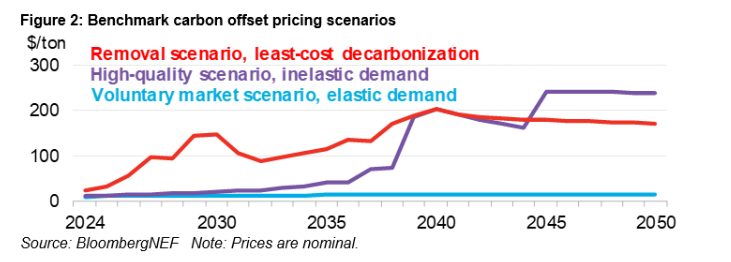INSIGHT by BloombergNEF (BNEF)
BNEF’s Long-Term Carbon Offsets Outlook 2024 shows that the success of the carbon offset market will be determined by the strength of demand and credibility of credits
Ongoing scrutiny and reputational issues made 2023 a challenging year for the voluntary carbon market. 2024 is set to be a determining year for the future of the market, tied to whether confidence in carbon credits can be restored. Doing so could drive companies to purchase billions of carbon credits annually, elevate prices over $200 per ton and build a market valued at over $1.1 trillion annually by 2050. However, failure could result in the death of the broader market, according to BloombergNEF’s (BNEF’s) Long-Term Carbon Offsets Outlook 2024 report.
According to BNEF, demand is the key variable that will determine the fate of the voluntary carbon market, which allows for the trading of verified emission reduction credits. 2023’s figures show a new annual demand record, but this was up just 2 percent from the previous watermark set in 2021 (161 to 163.6 million). Moreover, the market is heavily oversupplied – to the tune of nearly 50% in 2023 – but many companies have shown elasticity of demand and abandoned offsets for fear of criticism and rising prices. Should this elastic demand persist in the current market as prices rise, companies could purchase 1 billion offsets annually in 2030, leveling off to 2.5 billion in 2050.
Have you already read?
Kyle Harrison, Head of Sustainability Research at BNEF and the lead author of the report said, “There is no shortage of governments and investors that are eager to monetize emission reductions through carbon credits and channel financing towards projects. But if buyers can’t trust the quality of the credits they’re buying and risk greenwashing accusations, then the market will never reach its potential. Credits will never be more than discretionary spend in this case.”
Currently, initiatives such as the Integrity Council on Voluntary Carbon Markets, coupled with new guidance from regulators like the US Commodities Futures Trading Commission, are all focused on strengthening trust in carbon credits. The success of these groups could ensure carbon credits are a critical part of corporate decarbonization strategies regardless of their prices, known as inelastic demand, leading companies to potentially purchase up to 1.4 billion credits annually in 2030 and 5.9 billion in 2050. The success of these initiatives could alternatively lead to carbon credits being viewed as a viable substitute for other forms of abatement, determined purely by cost. This least-cost decarbonization approach could catalyze the purchase of up to 1.6 billion credits in 2030 and 5.1 billion in 2050.
The report details three scenarios for future carbon offset prices, dependent on what the future structure of the market and demand look like. In BNEF’s High-quality scenario, integrity issues in the offset market are resolved and offset demand is inelastic. Under the Voluntary market scenario, these integrity issues are not resolved and company demand is elastic. In BNEF’s Removal scenario, companies can only buy carbon removals and credits are interchangeable with other forms of abatement, meaning companies take a least-cost decarbonization approach.
In BNEF’s High-quality scenario, prices are low in early years, reaching just $20/ton in 2030, but begin rising rapidly as milestone years for net-zero goals approach and reach $238/ton in 2050. At this point, the market is valued at $1.1 trillion annually.
Under the Voluntary market scenario, prices reach just $13/ton in 2030 and a mere $14/ton in 2050. This would drive significant criticism around credits being a “right to pollute” for heavy-emitting companies. The market would peak at a value of just $34 billion annually in 2050, up from $2 billion today.
Finally, in the Removal scenario, prices reach an impressive $146/ton in 2030 and $172/ton in 2050. This market would have an annual value exceeding $884 billion in 2050, showcasing the importance of righting the ship in the voluntary carbon market and keeping demand strong.
“The lack of progress at COP28 on Article 6 has been a wakeup call to the importance of the voluntary carbon market,” said Harrison. “The private sector has been hard at work to position carbon credits as a complement to a suite of other decarbonization options, including the compliance market. Their success may just be the difference between the private sector achieving or not achieving its net-zero goals.”
| about
Bloomberg, the global business and financial information and news leader, gives influential decision makers a critical edge by connecting them to a dynamic network of information, people and ideas. The company’s strength – delivering data, news and analytics through innovative technology, quickly and accurately – is at the core of the Bloomberg Terminal. Bloomberg’s enterprise solutions build on the company’s core strength: leveraging technology to allow customers to access, integrate, distribute and manage data and information across organizations more efficiently and effectively. For more information, visit Bloomberg.com/company or request a demo.
BloombergNEF (BNEF) is a strategic research provider covering global commodity markets and the disruptive technologies driving the transition to a low-carbon economy. Our expert coverage assesses pathways for the power, transport, industry, buildings and agriculture sectors to adapt to the energy transition. We help commodity trading, corporate strategy, finance and policy professionals navigate change and generate opportunities.
| All opinions expressed are those of the author and/or quoted sources. investESG.eu is an independent and neutral platform dedicated to generating debate around ESG investing topics.











